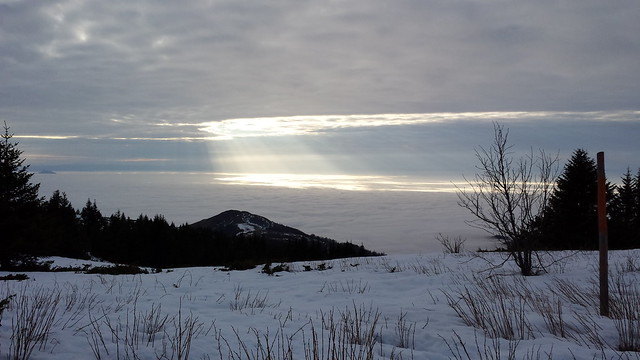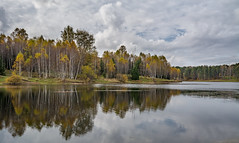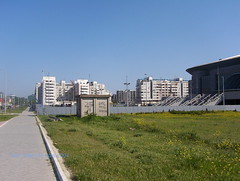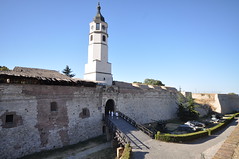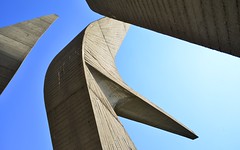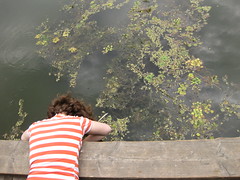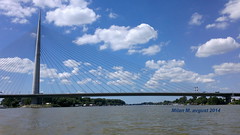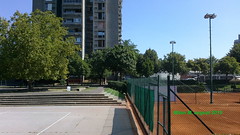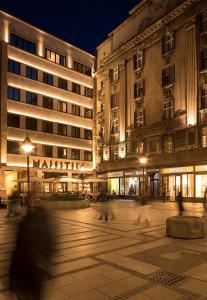 Serbia
Serbia
Serbia (English: /ˈsbiə/, ; Serbian: , , Serbo-croatian: [sř̩bija]), officially the Republic of Serbia (Serbian: , , Serbo-croatian: [repǔblika sř̩bija]), is a landlocked country in Southeastern and Central Europe, situated at the crossroads of the Pannonian Basin and the Balkans. It shares land borders with Hungary to the north, Romania to the northeast, Bulgaria to the southeast, North Macedonia to the south, Croatia and Bosnia and Herzegovina to the west, and Montenegro to the southwest, and claims a border with Albania through the disputed territory of Kosovo.Serbia without Kosovo has about 6.7 million inhabitants, about 8.4 million if Kosovo is included. Its capital Belgrade is also the largest city.
Continuously inhabited since the Paleolithic Age, the territory of modern-day Serbia faced Slavic migrations in the 6th century, establishing several regional states in the early Middle Ages at times recognised as tributaries to the Byzantine, Frankish and Hungarian kingdoms. The Serbian Kingdom obtained recognition by the Holy See and Constantinople in 1217, reaching its territorial apex in 1346 as the Serbian Empire. By the mid-16th century, the Ottomans annexed the entirety of modern-day Serbia; their rule was at times interrupted by the Habsburg Empire, which began expanding towards Central Serbia from the end of the 17th century while maintaining a foothold in Vojvodina. In the early 19th century, the Serbian Revolution established the nation-state as the region's first constitutional monarchy, which subsequently expanded its territory. Following casualties in World War I, and the subsequent unification of the former Habsburg crownland of Vojvodina with Serbia, the country co-founded Yugoslavia with other South Slavic nations, which would exist in various political formations until the Yugoslav Wars of the 1990s. During the breakup of Yugoslavia, Serbia formed a union with Montenegro, which was peacefully dissolved in 2006, restoring Serbia's independence as a sovereign state for the first time since 1918. In 2008, representatives of the Assembly of Kosovo unilaterally declared independence, with mixed responses from the international community while Serbia continues to claim it as part of its own sovereign territory.
Serbia is an upper-middle income economy, ranked "very high" in the Human Development Index domain (63rd position). It is a unitary parliamentary constitutional republic, member of the UN, CoE, OSCE, PfP, BSEC, CEFTA, and is acceding to the WTO. Since 2014, the country has been negotiating its EU accession, with the aim of joining the European Union by 2025. Serbia formally adheres to the policy of military neutrality. The country provides universal health care and free primary and secondary education to its citizens.
Etymology
The origin of the name Serbia is unclear. Historically, authors have mentioned the Serbs (Serbian: Srbi / Срби) and the Sorbs of Eastern Germany (Upper Sorbian: Serbja; Lower Sorbian: Serby) in a variety of ways: Cervetiis (Servetiis), gentis , Suurbi, Sorabi, Soraborum, Sorabos, Surpe, Sorabici, Sorabiet, Sarbin, Swrbjn, Servians, Sorbi, Sirbia, Sribia, Zirbia, Zribia, Suurbelant, Surbia, Serbulia / Sorbulia among others. These authors used these names to refer to Serbs and Sorbs in areas where their historical and current presence is not disputable (notably in the Balkans and Lusatia). However, there are also sources that mention the same or similar names in other parts of the World (most notably in the Asiatic Sarmatia in the Caucasus).
There exist two prevailing theories on the origin of the ethnonym *Sŕbъ (plur. *Sŕby), one from a Proto-Slavic language with an appellative meaning of a "family kinship" and "alliance", while another from an Iranian-Sarmatian language with various meanings. In his work, De Administrando Imperio, Constantine VII Porphyrogenitus suggests that the Serbs originated from White Serbia near Francia. According to the recorded tradition the White Serbs split in two, with the half that became known as the Serbs coming down to settle Byzantine land.
From 1815 to 1882, the official name for Serbia was the Principality of Serbia. From 1882 to 1918, it was renamed to the Kingdom of Serbia, later from 1945 to 1963, the official name for Serbia was the People's Republic of Serbia. This was again renamed the Socialist Republic of Serbia from 1963 to 1990. Since 1990, the official name of the country has been the Republic of Serbia.
History
Prehistory and antiquity
Archaeological evidence of Paleolithic settlements on the territory of present-day Serbia is scarce. A fragment of a human jaw was found in Sićevo (Mala Balanica) and is believed to be up to 525,000–397,000 years old.
Approximately around 6,500 years BC, during the Neolithic, the Starčevo and Vinča cultures existed in the region of modern-day Belgrade. They dominated much of Southeastern Europe (as well as parts of Central Europe and Asia Minor). Several important archaeological sites from this era, including Lepenski Vir and Vinča-Belo Brdo, still exist near the banks of the Danube.
During the Iron Age, local tribes of Triballi, Dardani, and Autariatae were encountered by the Ancient Greeks during their cultural and political expansion into the region, from the 5th up to the 2nd century BC. The Celtic tribe of Scordisci settled throughout the area in the 3rd century BC. It formed a tribal state, building several fortifications, including their capital at Singidunum (present-day Belgrade) and Naissos (present-day Niš).
The Romans conquered much of the territory in the 2nd century BC. In 167 BC, the Roman province of Illyricum was established; the remainder was conquered around 75 BC, forming the Roman province of Moesia Superior; the modern-day Srem region was conquered in 9 BC; and Bačka and Banat in 106 AD after the Dacian Wars. As a result of this, contemporary Serbia extends fully or partially over several former Roman provinces, including Moesia, Pannonia, Praevalitana, Dalmatia, Dacia, and Macedonia.
The chief towns of Upper Moesia (and broader) were: Singidunum (Belgrade), Viminacium (now Old Kostolac), Remesiana (now Bela Palanka), Naissos (Niš), and Sirmium (now Sremska Mitrovica), the latter of which served as a Roman capital during the Tetrarchy. Seventeen Roman Emperors were born in the area of modern-day Serbia, second only to contemporary Italy. The most famous of these was Constantine the Great, the first Christian Emperor, who issued an edict ordering religious tolerance throughout the Empire.
When the Roman Empire was divided in 395, most of Serbia remained under the Eastern Roman Empire. At the same time, its northwestern parts were included in the Western Roman Empire. By the 6th century, South Slavs migrated into the European provinces of the Byzantine Empire in large numbers. They merged with the local Romanised population that was gradually assimilated.
Middle Ages
White Serbs, an early Slavic tribe from White Serbia eventually settled in an area between the Sava river and the Dinaric Alps. By the beginning of the 9th century, Serbia achieved a level of statehood. Christianization of Serbia was a gradual process, finalized by the middle of the 9th century. In the mid-10th-century, the Serbian state stretched between the Adriatic Sea, the Neretva, the Sava, the Morava, and Skadar. During the 11th and 12th century, Serbian state frequently fought with the neighbouring Byzantine Empire. Between 1166 and 1371, Serbia was ruled by the Nemanjić dynasty (whose legacy is especially cherished), under whom the state was elevated to a kingdom in 1217, and an empire in 1346, under Stefan Dušan. Serbian Orthodox Church was organized as an autocephalous archbishopric in 1219, through the effort of Sava, the country's patron saint, and in 1346 it was raised to the Patriarchate. Monuments of the Nemanjić period survive in many monasteries (several being World Heritage sites) and fortifications.
During these centuries the Serbian state (and influence) expanded significantly. The northern part (modern Vojvodina), was ruled by the Kingdom of Hungary. The period after 1371, known as the Fall of the Serbian Empire saw the once-powerful state fragmented into several principalities, culminating in the Battle of Kosovo (1389) against the rising Ottoman Empire. The Ottomans finally conquered the Serbian Despotate in 1459. The Ottoman threat and eventual conquest saw massive migrations of Serbs to the west and north.
Ottoman and Habsburg rule
In all Serbian lands conquered by the Ottomans, the native nobility was eliminated and the peasantry was enserfed to Ottoman rulers, while much of the clergy fled or were confined to the isolated monasteries. Under the Ottoman system, Serbs, as well as Christians, were considered an inferior class of people and subjected to heavy taxes, and a portion of the Serbian population experienced Islamization. Many Serbs were recruited during the devshirme system, a form of slavery in the Ottoman Empire, in which boys from Balkan Christian families were forcibly converted to Islam and trained for infantry units of the Ottoman army known as the Janissaries. The Serbian Patriarchate of Peć was extinguished in 1463, but reestablished in 1557, providing for limited continuation of Serbian cultural traditions within the Ottoman Empire, under the Millet system.
After the loss of statehood to the Ottoman Empire, Serbian resistance continued in northern regions (modern Vojvodina), under titular despots (until 1537), and popular leaders like Jovan Nenad (1526–1527). From 1521 to 1552, Ottomans conquered Belgrade and regions of Syrmia, Bačka, and Banat. Continuing wars and various rebellions constantly challenged Ottoman rule. One of the most significant was the Banat Uprising in 1594 and 1595, which was part of the Long War (1593–1606) between the Habsburgs and the Ottomans. The area of modern Vojvodina endured a century-long Ottoman occupation before being ceded to the Habsburg Empire,…
Hotels Serbia
Looking for places related to Serbia?
Those are other destinations to find places related to Serbia:
